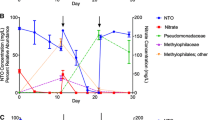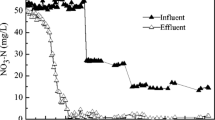Abstract
Results of batch experiments on the denitrifying degradation of dimethyl phthalate (DMP) was most favorable at pH 7–9 and 30–35°C. DMP was first degraded to monomethyl phthalate (MMP), which was in turn degraded to phthalate before complete mineralization. There was no fatty acid residue in the mixed liquor throughout the experiments. The maximum specific degradation rates were 0.32 mM/(gVSS·h) for DMP, 0.19 mM/(gVSS·h) for MMP, and 0.14 mM/(gVSS·h) for phthalate. About 86% of available electron in DMP was utilized for denitrification; the remaining 14% was presumable conserved in the new biomass with an estimated yield of 0.17 mg/mg DMP. Based on 16S rDNA analysis, the denitrifying sludge was mainly composed of β-subdivision and α-subdivision of Proteobacteria (33 and 5 clones out of a total of 43 clones, respectively), plus some Acidobacteria. Using a primer set specifically designed to amplify the denitrification nirK gene, 10 operational taxonomy units (OTUs) were recovered from the clone library. They clustered into a group in the α-subdivision of Proteobacteria most closely related to denitrifier Bradyrhizobium japonicum USDA110 and several environmental clones.






Similar content being viewed by others
References
Aftring RP, Taylor BF (1981) Aerobic and anaerobic catabolism of phthalic acid by a nitrate-respiring bacterium. Arch Microbiol 130:101–104
Baek SH, Kim KH, Yin CR, Jeon CO, Im WT, Kim KK, Lee ST (2003) Isolation and characterization of bacteria capable of degrading phenol and reducing nitrate under low-oxygen conditions. Curr Microbiol 47:462–466
Bauer MJ, Herrmann R, Martin A, Zellmann H (1998) Chemodynamics, transport behaviour and treatment of phthalic acid esters in municipal landfill leachates. Water Sci Technol 38(2):185–192
Crosby DG (1998) Environmental toxicology and chemistry. Oxford University Press, USA
Etchebehere C, Errazquin MI, Dabert P, Muxi L (2002) Community analysis of a denitrifying reactor treating landfill leachate. FEMS Microbiol Ecol 40:97–106
Fromme H, Küchlerb T, Ottoc T, Pilz K, Müllerb J, Wenzel A (2002) Occurrence of phthalates and bisphenol A and F in the environment. Wat Res 36:1429–1438
Glass C, Silverstein J, Oh J (1997) Inhibition of denitrification in activated sludge by nitrite. Water Environ Res 69:1086–1093
Hales BA, Edwards C, Ritchie DA, Hall G, Pickup RW, Saunders JR (1996) Isolation and identification of methanogen-specific DNA from blanket bog feat by PCR amplification and sequence analysis. Appl Environ Microbiol 62:668–675
Henry S, Baudoin E, López-Gutiérrez JC, Martin-Laurent F, Brauman A, Philippot L (2004) Quantification of denitrifying bacteria in soils by nirK gene targeted real-time PCR. J Microbiol Methods 59:327–335
Juneson C, Ward OP, Singh A (2002) Biodegradation of dimethyl phthalate with high removal rates in a packed-bed reactor. World J Microbiol Biotechnol 18:7–10
Kleerebezem R, Pol LWH, Lettinga G (1999a) Anaerobic degradation of phthalate isomers by methanogenic consortia. Appl Environ Microbiol 65:1152–1160
Kleerebezem R, Pol LWH, Lettinga G (1999b) Anaerobic biodegradability of phthalic acid isomers and related compounds. Biodegradation 10:63–73
Knudsen FR, Pottinger TG (1999) Interaction of endocrine disrupting chemicals, singly and in combination, with estrogen-, androgen-, and corticosteroid-binding sites in rainbow trout (Oncorhynchus mykiss). Aquat Toxicol 44:159–170
Liu WT, Marsh TL, Cheng H, Forney LJ (1997) Characterization of microbial diversity by determining terminal restriction fragment length polymorphisms of genes encoding 16S rDNA. Appl Environ Microbiol 63:4516–4522
Marttinen SK, Kettunen RH, Rintala JA (2003a) Occurrence and removal of organic pollutants in sewages and landfill leachates. Sci Total Environ 301:1–12
Marttinen SK, Kettunen RH, Sormunen KM, Rintala JA (2003b) Removal of bis(2-ethylhexyl) phthalate at a sewage treatment plant. Water Res 37:1385–1393
Mechichi T, Stackebrandt E, Gad’on N, Fuchs G (2002) Phylogenetic and metabolic diversity of bacteria degrading aromatic compounds under denitrifying conditions, and description of Thauera phenylacetica sp. nov., Thauera aminoaromatica sp. nov., and Azoarcus buckelii sp. nov. Arch Microbiol 178:26–35
Muyzer G, Teske A, Wirsen CO, Jannasch HW (1995) Phylogenetic relationship of Thiomicrospira species and their identification in deep-sea hydrothermal vent samples by denaturing gradient gel electrophoresis of 16S rDNA fragments. Arch Microbiol 164:165–172
Nozawa T, Maruyama Y (1988) Anaerobic metabolism of phthalate and other aromatic compounds by a denitrifying bacterium. J Bacteriol 170:5778–5784
Okano R, Takazaki H, Matsuba D, Tokuyama T, Sato Y, Wakabayashi K (2004) Nitrosomonas europaea ATCC25978 is the right ammonia-oxidizing bacterium for screening nitrification inhibitors. Journal of Pesticide Science 29:50–52
Purkhold U, Pommerening-Roser A, Juretschko S, Schmid MC, Koops HP, Wagner M (2000) Phylogeny of all recognized species of ammonia oxidizers based on comparative 16S rRNA and amoA sequence analysis: implications for molecular diversity surveys. Appl Environ Microbiol 66:5368–5382
Qiu XY, Hurt RA, Wu LY, Chen CH, Tiedje JM, Zhou Z (2004) Detection and quantification of copper-denitrifying bacteria by quantitative competitive PCR. J Microbiol Methods 59:199–210
Rabus R, Widdel F (1995) Anaerobic degradation of ethylbenzene and other aromatic hydrocarbons by new denitrifying bacteria. Arch Microbiol 163:96–103
Shelton DR, Boyd SA, Tiedje JM (1984) Anaerobic biodegradation of phthalic acid esters in sludge. Environ Sci Technol 18:93–97
Song B, Ward BB (2003) Nitrite reductase genes in halobenzoate degrading denitrifying bacteria. FEMS Microbiol Ecol 43:349–357
Staples CA, Peterson DR, Parkerton TF, Adams WJ (1997) The environmental fate of phthalate esters: a literature review. Chemosphere 35:667–749
Tur MY, Huang JC (1997) Treatment of phthalic waste by anaerobic hybrid reactor. J Environ Eng 123:1093–1099
Wagner M, Roger AJ, Flax JL, Brusseau GA, Stahl DA (1998) Phylogeny of dissimilatory sulfite reductases supports an early origin of sulfate respiration. J Bacteriol 180:2975–2982
Wang JL, Liu P, Qian Y (1999) Microbial metabolism of di-butyl phthalate (DBP) by a denitrifying bacterium. Process Biochem 34:745–749
Wang JL, Chen LJ, Shi HC, Qian Y (2000) Microbial degradation of phthalic acid esters under anaerobic digestion of sludge. Chemosphere 41:1245–1248
Wang JL, Ye YC, Wu WZ (2003) Comparison of di-n-methyl phthalate biodegradation by free and immobilized microbial cells. Biomed Environ Sci 16:126–132
Wang Y, Fan Y, Gu JD (2004) Dimethyl phthalate ester degradation by two planktonic and immobilized bacterial consortia. Inter Biodeterior Biodegrad 53:93–101
Velasco L, Mesa S, Delgado MJ, Bedmar EJ (2001) Characterization of the nirK gene encoding the respiratory, Cu-containing nitrite reductase of Bradyrhizobium japonicum. Biochim Biophys Acta–Gene Structure and Expression 1521:130–134
von Wintzingerode F, Selent B, Hegemann W, Gobel UB (1999) Phylogenetic analysis of an anaerobic, trichlorobenzene-transforming microbial consortium. Appl Environ Microbiol 65:283–286
Yarbrough JM, Rake JB, Eagon RG (1980) Bacterial inhibitory effects of nitrite-inhibition of active-transport, but not of group translocation, and of intracellular enzymes. Appl Environ Microbiol 39:831–834
Acknowledgements
The authors wish to thank the Hong Kong Research Grants Council for the financial support of this study (HKU 7107/03E), and Da-Wei Liang wishes to thank the University of Hong Kong for the postgraduate studentship.
Author information
Authors and Affiliations
Corresponding author
Rights and permissions
About this article
Cite this article
Liang, DW., Zhang, T. & Fang, H.H.P. Denitrifying degradation of dimethyl phthalate. Appl Microbiol Biotechnol 74, 221–229 (2007). https://doi.org/10.1007/s00253-006-0653-6
Received:
Revised:
Accepted:
Published:
Issue Date:
DOI: https://doi.org/10.1007/s00253-006-0653-6




